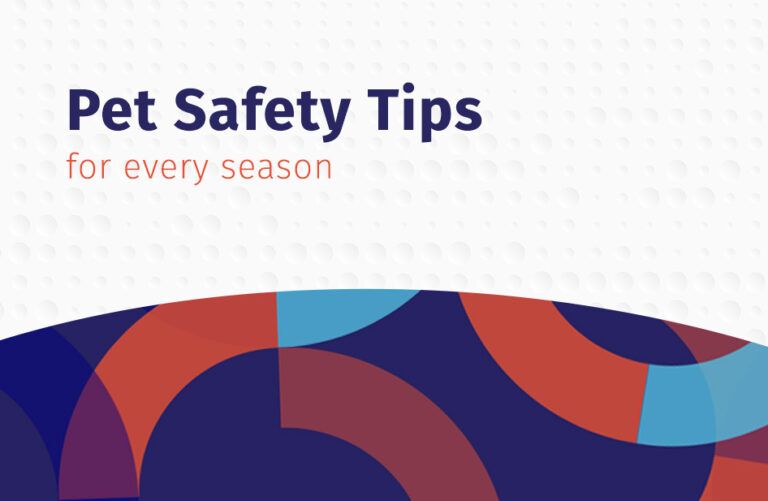As the seasons change throughout the year, each one presents challenges to your patients, from blazing heat to frigid snow, or even rainy-day puddles. Keeping these risks top of mind for your veterinary staff as well as pet owners is another way you can provide exceptional patient care. We’ve rounded up the top reminders for each season into a printable tip sheet to share with your clients. Our list below also includes best practices you can use in your own hospital!
Winter
- Antifreeze and driveway salt can be dangerous to pets if ingested. Remind pet owners they can use pet-friendly de-icing products, or that they should be sure to wipe their pet’s paws thoroughly to remove residue after winter walks or outings.
- Communicate with pet owners how to keep their pets safe in cold temperatures. Pet’s paws should be dried off whenever they come inside and time outside in cold or freezing temperatures should be limited to eliminate the chances of frostbite and hypothermia.
- For owners who like to keep holiday décor out longer than most, share our holiday safety tips to keep them up to date on the top risks for pets.
- Snow and ice are as much a threat to pets as they are to humans. Remind owners to keep driveways, walkways, and stairs clear of snow and ice to prevent any injuries from slips or falls—do the same at your practice to keep patients, clients, and staff safe
Practice Tip:
Outfitting your staff with branded outdoor gear, such as hats and gloves, when providing curbside services keeps them visible and warm.
Spring
- Allergies can affect pets just like they do humans. Arm pet owners with the latest information on pet allergies.
- As the weather becomes warmer and annual spring cleaning takes effect, remind pet owners of poisonous household cleaning products that can be dangerous for pets even to smell. Prompt them to open windows to provide ventilation.
- Flowers and plants are another risk to pets, many being poisonous if ingested. Keep a shareable list on-hand of the flowers and plants that pose a danger to give to your pet owners who love to garden or landscape.
- Puddles from the winter runoff or spring rainstorms are appealing to pets when they get thirsty on a walk, but their contents are dangerous. Leptospira is a common bacterium that lives in dirty water that can cause infection. Remind your pet owners to not let their dogs drink from outside puddles.
Practice Tip:
Spring is a great time to restock the shelves with cleaning supplies and PPE and check the condition of the clinic’s leashes. For curbside services, provide umbrellas to your staff with an accessible way to store them, and place water-absorbent mats at all doorways.
Want to keep this list of safety reminders on-hand all year?
Download the complete tip sheet!
(It makes a great print-out for your practice!)
Summer
- Overheating is a primary and common danger of the summer months. Inform pet owners of the best ways to prevent overheating along with the signs of heatstroke in pets.
- Hydration is crucial for pets in the summer, especially after long periods outside or when taking dogs on walks. Emphasize with pet owners the importance of carrying water with them when taking their dog anywhere.
- Offering curbside veterinary practices? If so, consider taking patients right inside when they arrive for their appointment versus letting them sit in the car until it’s their time. You can also offer complimentary water while they wait.
Autumn
- Ticks are a threat throughout the United States and can cause a variety of diseases in cats and dogs, most notably Lyme disease. If not treated quickly and properly, ticks and tick bites can cause serious harm. Remind pet owners of the dangers of ticks and show them how to best conduct daily ‘tick checks’ on their pet. Educate owners on the types of areas ticks are most prevalent and how to best avoid those risks.
- Halloween and Thanksgiving are known for their foods, but candy and turkey have risks for pets. Plus, pet anxiety is a common challenge during large gatherings. Share some safety tips with pet owners for candy storage and pet-safe party tips.
- Leaf piles and large branches can create potential hazards or opportunities for injury. Educate owners on safe habits during hikes and walks.
Practice Tip:
Autumn is a great time to remind pet owners to check their pet’s ID tags and microchip and book pet care services for the upcoming holidays.



